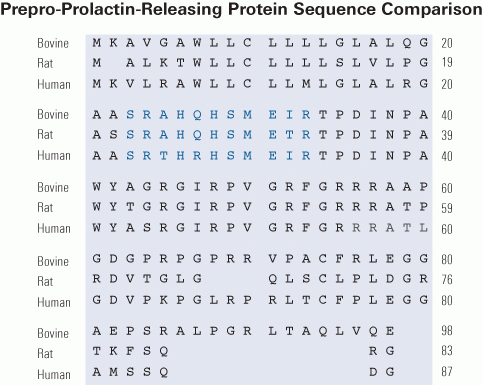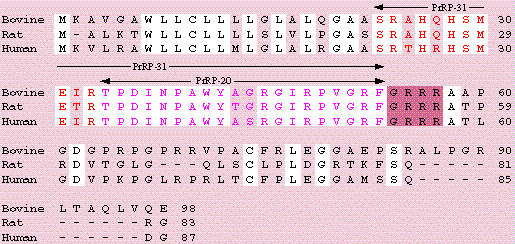


To identify new drug targets for the treatment of obesity, we employed a degenerate reverse transcriptasepolymerase chain reaction technique to isolate novel members of the G-protein coupled receptor superfamily from mouse hypothalamus. One of our clones was found to encode a protein with 90% amino acid identity to human GPR10, which was previously identified as the receptor for prolactin-releasing peptide (PrRP) and has been implicated in lactation, the regulation of food intake and other physiological functions. To investigate the role of GPR10 in food intake and body weight homeostasis, we generated mice carrying a targeted deletion of the GPR10 gene. First, using these knockout animals, we confirmed that GPR10 is the principle receptor for PrRP in the mouse hypothalamus because deletion of GPR10 completely abolished PrRP binding to isolated hypothalamic cell membranes. Second, we investigated the effect of normal and high-fat diets on energy intake, body weight, and glucose homeostasis in wild-type and GPR10 knockout mice. After fasting and refeeding, food intake in knockout animals was unchanged relative to control littermates. However, beginning at 16 wk of age on a normal diet, knockout mice became hyperphagic, obese, and showed significant increases in body fat and the levels of leptin and insulin, as well as decreased glucose tolerance. This metabolic profile was similar to the effect of a high-fat diet on wild-type animals. Our findings provide direct evidence that GPR10 is the receptor for PrRP and that it is involved in the regulation of energy balance in mice. GPR10 knockout mice will also prove useful for investigating other proposed activities for PrRP.
Gu W, Geddes BJ, Zhang C, Foley KP, Stricker-krongrad A. The prolactin-releasing peptide receptor (GPR10) regulates body weight homeostasis in mice. J Mol Neurosci. 2004;22(1-2):93-103.
The physiological relevance of the recently described prolactin-releasing peptides (PrRPs) has yet to be established. Here, we demonstrate the low potency of the PrRPs (minimum effective dose: 100 nM), compared to that observed for thyrotropin-releasing hormone (TRH, minimum effective dose: 1.0 nM), to stimulate prolactin (PRL) release from cultured pituitary cells harvested from lactating female rats. Anatomic studies question the role of these peptides in neuroendocrine control of lactotroph function. Instead, peptide and peptide receptor mapping studies suggest potential actions in hypothalamus and brainstem unrelated to the control of anterior pituitary hormone secretion. Intracerebroventricular (i.c.v. ) administration of both PrRP-20 and PrRP-31 (0.4 and 4.0 nmol) resulted in significantly increased mean arterial blood pressure in conscious, unrestrained rats [peak elevations vs. baseline: PrRP-20, 10% and 16%, low and high dose peptide; PrRP-31, 7% and 10%; compared to the response to 0.1 nmol angiotensin II (A II), 15-17%]. Similar doses of peptide did not significantly alter water drinking in response to overnight fluid deprivation, or thirst or salt appetite in response to an isotonic hypovolemic challenge. Thus, the effect on blood pressure appeared relatively specific. We suggest that these peptides, identified originally as ligands for a receptor found in abundance in pituitary gland, play a broader role in brain function and that the ability of them to stimulate PRL release may not represent their primary biologic function.
Samson WK, Resch ZT, Murphy TC. A novel action of the newly described prolactin-releasing peptides: cardiovascular regulation. Brain Res. 2000;858(1):19-25.
1 GPR10 is a novel G-protein coupled receptor that is the human orthologue of rat Unknown Hypothalamic Receptor-1 (UHR-1). Human prolactin-releasing peptide (PrRP) has been identi®ed as an endogenous ligand for GPR10, and occurs as 31 and 20 amino acid forms. The present study characterizes the binding of [125I]-PrRP-20 to HEK293 cells stably expressing GPR10 receptors. 2 Speci®c binding of [125I]-PrRP-20 was saturable, and analysis suggested evidence of both high and low anity sites, with KD values of 0.026+0.006 and 0.57+0.14 nM respectively, and Bmax values of 3010+400 and 8570+2240 fmol mg protein71 respectively. Kinetic studies were unable to distinguish two sites, but single site analysis of association and dissociation data produced a KD of 0.012 nM. 3 Competition studies revealed that human and rat PrRP-20 and PrRP-31 all display high anity for GPR10. A range of other drugs which are known ligands at receptors which share limited homology with GPR10 were also tested. None of the drugs tested, including the RF-amide neuropeptide FF, demonstrated any anity for GPR10. 4 Human PrRP-20 failed to alter basal or forskolin-stimulated levels of intracellular cyclic AMP in HEK293-GPR10 cells, suggesting that GPR10 does not couple via either Gs or Gi. 5 Functional studies using measurements of intracellular calcium con®rmed that human and rat PrRP-20 and PrRP-31 are all potent, full agonists at the GPR10 receptor. The response was blocked both by thapsigargin, indicating mobilization of intracellular Ca2+ stores. 6 These studies indicate that [125I]-PrRP-20 is a speci®c, high anity radioligand for GPR10. The availability of this radioligand binding assay will be a valuable tool for the investigation of the key features involved in PrRP binding and studies on the localization and function of GPR10.
Langmead CJ, Szekeres PG, Chambers JK, et al. Characterization of the binding of [(125)I]-human prolactin releasing peptide (PrRP) to GPR10, a novel G protein coupled receptor. Br J Pharmacol. 2000;131(4):683-8.
Prolactin releasing peptide (PrRP) was recently purified from bovine hypothalamus and binds to the orphan receptor, UHR-1. We examined the distribution and kinetics of 125I-PrRP binding in rat tissues together with molecular characterization by chemical cross-linking and Northern blotting. In this study 125I-PrRP binding showed specificity and rapid association and dissociation. Specific binding was found in membranes from rat tissues including brain (hypothalamus, medulla oblongata and cerebellum), pituitary, heart, soleus muscle, adipose tissue, kidney, adrenal gland, testis and small intestine. In hypothalamus, pituitary, heart and soleus competition analysis indicated only one class of binding site in each tissue. Binding affinity for PrRP (IC50) and binding site density (Bmax) respectively were 5.2±0.9 nm and 674±97 fmol mg protein 1 in hypothalamus (n=5), 1.4±0.6 nm and 541±126 fmol mg protein 1 in pituitary (n=3), 6.6±0.7 nm and 628±74 fmol mg protein 1 in heart (n=4) and 9.8±0.9?nm and 677±121 fmol mg protein 1 in soleus muscle (n=4). Analysis of 125I-PrRP-binding site complexes by chemical cross-linking showed a binding site Mr of 69,000 in hypothalamus and 41,000 in heart and soleus. Northern analysis of polyA+ RNA from hypothalamus showed a 4.2?kb band as expected for UHR-1, but heart and soleus showed a 4.8?kb band. Taken together these results indicate that there may be different subtypes of PrRP binding sites in rat tissues which may differ from UHR-1.
Satoh F, Smith DM, Gardiner JV, et al. Characterization and distribution of prolactin releasing peptide (PrRP) binding sites in the rat--evidence for a novel binding site subtype in cardiac and skeletal muscle. Br J Pharmacol. 2000;129(8):1787-93.
Prolactin-releasing peptide (PrRP) is a peptide ligand for the human orphan G-protein-coupled receptor hGR3/GPR10 and causes the secretion of prolactin from anterior pituitary cells. However, the lack of immunoreactive staining for PrRP in the external layer of the median eminence seems to rule out this peptide as a classical hypophysiotropic hormone and, furthermore, PrRP is less effective than another inducer of prolactin secretion, thyrotropin-releasing hormone, both in vitro and in vivo. Here we show a reduction in the expression of PrRP mRNA during lactation and fasting and an acute effect of PrRP on food intake and body weight, supporting the hypothesis of an alternative role for the peptide.
Lawrence CB, Celsi F, Brennand J, Luckman SM. Alternative role for prolactin-releasing peptide in the regulation of food intake. Nat Neurosci. 2000;3(7):645-6.
We established a sensitive and specific two-site enzyme immunoassay (EIA) for prolactin-releasing peptide (PrRP) using two region-specific monoclonal antibodies. We investigated the tissue distribution and the plasma concentration of immunoreactive (ir-) PrRP in rats using this assay. Ir-PrRP was widely distributed in the central nervous system and pituitary gland. The highest concentration of ir-PrRP was found in the hypothalamus. In peripheral tissues, appreciable levels of ir-PrRP were found only in the adrenal gland. The mean plasma concentration of ir-PrRP was 0.13 +/- 0.01 fmol/ml (mean +/- SEM). In reverse-phase and gel-filtration high performance liquid chromatography, hypothalamic ir-PrRP eluted at a position identical to that of PrRP31 and PrRP20. On the other hand, ir-PrRP from the adrenal gland and plasma eluted only at the position of synthetic PrRP31, indicating that molecular forms of ir-PrRP in vivo differed among tissues.
Matsumoto H, Murakami Y, Horikoshi Y, et al. Distribution and characterization of immunoreactive prolactin-releasing peptide (PrRP) in rat tissue and plasma. Biochem Biophys Res Commun. 1999;257(2):264-8.
| Catalog# | Product | Standard Size | Price |
|---|---|---|---|
| G-008-52 | Prolactin-Releasing Peptide-31 (PrRP-31) (Rat) - Purified IgG Antibody | 400 µg | $571 |
| RK-008-52 | Prolactin-Releasing Peptide-31 (PrRP-31) (Rat) - RIA Kit | 125 tubes | $880 |
| FR-008-52 | Prolactin-Releasing Peptide-31 (PrRP-31) (Rat) - Rhodamine Labeled | 1 nmol | $317 |
| WBK-008-52 | Prolactin-Releasing Peptide-31 (PrRP-31) (Rat) - Western Blot Kit | 1 kit | $777 |
Social Network Confirmation